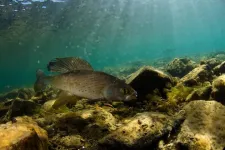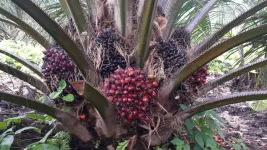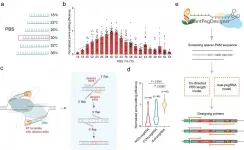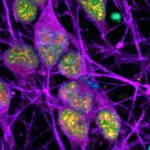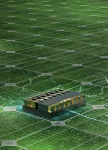(Press-News.org) CORVALLIS, Ore. - Warm river habitats appear to play a larger than expected role supporting the survival of cold-water fish, such as salmon and trout, a new Oregon State University-led study published today found.
The research has important implications for fish conservation strategies. A common goal among scientists and policymakers is to identify and prioritize habitat for cold-water fish that remains suitably cool during the summer, especially as the climate warms.
This implicitly devalues areas that are seasonally warm, even if they are suitable for fish most of the year, said Jonny Armstrong, lead author of the paper and an ecologist at Oregon State. He called this a "potentially severe blind spot for climate change adaptation."
"Coldwater fish like trout and salmon are the polar bears of river ecosystems - iconic species that are among the most vulnerable to climate change," Armstrong said. "A huge challenge for conservation is to figure out how to help these fish survive a warmer future. The conclusion is that we should not waste money on warm habitats and instead focus on saving the coldest places, such as high mountain streams, which are already the most pristine parts of basins. Most people agree we should give up on places that are warm in summer, but forget that these places are actually optimal for much of the year."
In the new paper, published in Nature Climate Change, Armstrong and collaborators at Oregon State and several federal agencies, show that warm river habitats, typically lower in basins, provide pulses of growth potential during the spring and fall, so-called shoulder seasons, when the rivers are not at peak summer temperatures. Foraging in these warm habitats can provide fish the needed energy to travel to cooler parts of the river during the summer and to reproduce.
"The synergy between cold water and warm water is really important," said Armstrong, an assistant professor in the Department of Fisheries and Wildlife in the College of Agricultural Sciences. "We're not saying cold water is not important. We're saying that warm portions of basins are also important because they grow fish during the shoulder seasons. Conserving this habitat is critical for unlocking the full potential of rivers to support fisheries.
"In a warmer future, many fish will need fish to take a summer vacation and move to cold places to survive the hottest months of the year. Their ability to do that could often depend on how much energy they can get in the spring and how well they can feed in the fall to bounce back. The places that are stressfully warm in summer are just right in spring and fall, and there is growing evidence that they can fuel fisheries"
For the study, the researchers used data from another team of scientists that used remote sensing technology to obtain river water temperature data across entire landscapes throughout the year. That team compiled data for 14 river basins in Oregon, Washington and Idaho.
The OSU-led team plugged these temperature data into a "bioenergetics model" that predicts fish growth potential based on equations derived from lab studies. This provided new insights into how growth opportunities shift across river basins throughout the year, and how a large fraction of total growth potential can accrue during the spring and autumn in places that are too hot during summer.
To explore how these warm habitats could contribute to fisheries, the team created a simulation model in which virtual rainbow trout were given simple behavior rules and allowed to forage throughout the year in a basin with cold tributaries and a warm, productive main-stem river. Their simulations showed the majority of fish moved into cooler waters in the summer and exhibited meager growth rates. However, outside summer, the simulation showed the fish resided primarily in seasonally warm downstream habitats, which fueled the vast majority of their growth.
"In conservation, we often judge streams by their summer conditions; this is when we traditionally do field work, and this is the season we focus on when planning for climate change," Armstrong said. "We place value on places that hold fish during summer and devalue those that don't. Our simulation showed why this can be a problem - the portions of rivers that contribute most to growth may not be the places where fish are found during summer, so they get written off."
The simulations reveal the synergy between seasonally warm and perennially cool habitats and that fish that lived in these two types of habitats grew much more than fish that were restricted to either habitat alone, Armstrong said.
"We think of things in this binary way - it's either warm-water habitat or its cold-water habitat," Armstrong said. "And we have definitions for fish - it's either a warm-water fish or a cold-water fish. But the places we think of as warm are, in fact, cold way more than they are warm."
He then mentioned an example using rivers in Oregon, including the Willamette, a tributary of the Columbia River that runs nearly 200 miles from Eugene to Portland.
"When it's warm enough for humans to swim, it's bad for cold-water fish. But there's only like six weeks of the year where it is comfortable to go swimming in Oregon," Armstrong said. "That speaks to the fact that we write off places because they get too hot through the lens of August. They're actually pretty nice for most of the year if you're a cold-water fish. And fish don't necessarily have to live there in August, just like you don't have to go swimming in the Willamette in December."
INFORMATION:
This research is continuing in the field at Upper Klamath Lake in Southern Oregon, where Armstrong and a team of researchers are tracking the movement and feeding behavior of redband trout as water temperature changes.
Co-authors of the paper are Aimee Fullerton and Chris Jordan of the National Oceanic and Atmospheric Administration Northwest Fisheries Science Center; Joseph Ebersole of the Environmental Protection Agency; James Bellmore, Brooke Penaluna and Gordon Reeves of the U.S. Forest Service Pacific Northwest Research Station; and Ivan Arismendi of Oregon State.
Lithium-ion batteries have made possible the lightweight electronic devices whose portability we now take for granted, as well as the rapid expansion of electric vehicle production. But researchers around the world are continuing to push limits to achieve ever-greater energy densities -- the amount of energy that can be stored in a given mass of material -- in order to improve the performance of existing devices and potentially enable new applications such as long-range drones and robots.
One promising approach is the use of metal electrodes in place of the conventional graphite, with a higher charging ...
Many psychiatric disorders have genetic causes, but the exact mechanism of how genes influence higher brain function remains a mystery. A new study provides a map linking the genetic signature of functions across the human brain, a tool that may provide new targets for future treatments.
Led by Bratislav Misic, a researcher at The Neuro (Montreal Neurological Institute-Hospital) of McGill University, a group of scientists performed machine learning analysis of two Open Science datasets: the gene expression atlas from the Allen Human Brain Atlas and the functional ...
DURHAM, N.C. - Engineers at Duke University have developed an electronics-free, entirely soft robot shaped like a dragonfly that can skim across water and react to environmental conditions such as pH, temperature or the presence of oil. The proof-of-principle demonstration could be the precursor to more advanced, autonomous, long-range environmental sentinels for monitoring a wide range of potential telltale signs of problems.
The soft robot is described online March 25 in the journal Advanced Intelligent Systems.
Soft robots are a growing trend in the industry due to their versatility. Soft parts can handle delicate objects such as biological tissues that metal or ceramic components would damage. Soft bodies can help robots float or squeeze into tight spaces where rigid ...
Lincoln, Neb., March 25, 2021 -- Palm oil, the most important source of vegetable oil in the world, is derived from the fruit of perennial palm trees, which are farmed year-round in mostly tropical areas. The palm fruit is harvested manually every 10 days to two weeks, then transported to a mill for processing, and ultimately exported and made into a dizzying array of products from food to toiletries to biodiesel.
"You probably ate palm oil for breakfast," said Patricio Grassini, an associate professor of agronomy at the University of Nebraska-Lincoln. "There is probably palm oil in your ...
Precision genome editing enables the precise modification of DNA in living cells, thus enabling a breadth of opportunities for plant breeding. Prime editors, developed by Prof. David R. Liu and his colleagues, permit the installation of desired edits in a programmable target site. They are comprised of an engineered Cas9 nickase (H840A)-reverse transcriptase (RT) fusion protein and a prime editing guide RNA (pegRNA).
Prime editors were previously developed and optimized as an extremely versatile editing strategy for generating programmable point mutations, insertions and deletions in rice and wheat by Prof. GAO Caixia of the Institute of Genetics and Developmental Biology (IGDB) of the Chinese Academy of Sciences ...
Researchers at the National Institutes of Health (NIH) have discovered specific regions within the DNA of neurons that accumulate a certain type of damage (called single-strand breaks or SSBs). This accumulation of SSBs appears to be unique to neurons, and it challenges what is generally understood about the cause of DNA damage and its potential implications in neurodegenerative diseases.
Because neurons require considerable amounts of oxygen to function properly, they are exposed to high levels of free radicals--toxic compounds that can damage DNA within cells. ...
Fossil remains of the human pelvis are rare because the pelvic bones do not preserve very well. Therefore, it has remained unclear when human sex differences in the pelvis evolved: jointly with upright walking, or later, together with the large human brains. "We have discovered that the pattern of sex differences in the human pelvis is probably much older than previously thought", says evolutionary biologist Barbara Fischer.
A team of biologists from the University of Vienna, the KLI for Evolution and Cognition Research, and the University of Calgary compared pelvic sex differences in humans with those in chimpanzees, the most closely-related living species to modern ...
Power converters are the little-known systems that make electricity so magical. They are what allow us to plug in our computers, lamps and televisions and turn them on in a snap. Converters transform the alternating current (AC) that comes out of wall sockets into the exact level of direct current (DC) that our electronics need. But they also tend to lose, in average, up to 20% of their energy in the process.
Power converters work by using power transistors - tiny semiconductor components designed to switch on and off and withstand high voltages. Designing novel power transistors to improve the converters' efficiency is the aim of the team of EPFL engineers. With their entirely new transistor design, based on the counterintuitive application ...
University of Texas at Dallas researchers have discovered that a novel surface they developed to harvest water from the air encourages tiny water droplets to move spontaneously into larger droplets.
When researchers placed microdroplets of water on their liquid-lubricant surface, the microdroplets propelled themselves to climb, without external force, into larger droplets along an oily, ramp-shaped meniscus that forms from the lubricant around the larger droplets. The "coarsening droplet phenomenon" formed droplets large enough for harvesting.
"This meniscus-mediated climbing effect enabled rapid coalescence on hydrophilic ...
The evolving science of wisdom rests on the idea that wisdom's defined traits correspond to distinct regions of the brain, and that greater wisdom translates into greater happiness and life satisfaction while being less wise results in opposite, negative consequences.
Scientists have found in multiple studies that persons deemed to be wiser are less prone to feel lonely while those who are lonelier also tend to be less wise. In a new study, published in the March 25, 2021 issue of the journal Frontiers in Psychiatry, researchers at University of California San Diego School of Medicine take the connection between wisdom, loneliness ...
